Galaxy S7 vs iPhone 6s: The Choice Is Clear
Faster autofocus and water resistance are just two ways Samsung's Galaxy S7 and S7 Edge put pressure on Apple's iPhone 6s and 6s Plus.
Apple and Samsung have been slugging it out for the title of best smartphone for several years, and the Galaxy S7 has what it takes to take the title from Apple. The Galaxy S7 and S7 Edge both boast a breakthrough dual-pixel camerathat focuses superfast and offers excellent low-light performance. Plus, the new Samsungs have a water-resistant design that allows them to survive 30 minutes submerged. (You can't bob for your Apple phone — unless you want a paperweight.)

The iPhone 6s and iPhone 6s Plus have unique strengths, including immersive Live Photos and a pressure-sensitive 3D Touch display. Apple also benefits from having an App Store that gets the hottest apps first and offering iCloud for keeping your photos and other files backed up and synced across multiple devices. But overall, Samsung takes the crown in this hard-fought battle. Here's why.
Design
The Galaxy S7and S7 Edge continue the glass-and-metal look of their predecessors, in contrast to the aluminum case that encloses Apple's iPhones. The backs of the S7 and S7 Edge feature curved glass, making the devices easy to hold.
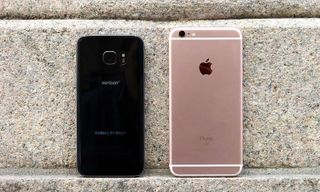
Both of the edges on the S7 Edge's screen are curved, allowing you to perform various functions with a swipe inward. Yes, the latest iPhones have a classically handsome aesthetic, but the Edge is the sexiest phone you can buy, period.

If you prefer a big-screen phone, it's no contest between the S7 Edge and iPhone 6s Plus. Samsung managed to cram the same-size 5.5-inch display as the iPhone has in a smaller and lighter body (5.53 ounces versus 6.77 ounces).
I could much more easily type with one hand on the S7 Edge than on the Plus. For its part, the iPhone 6s is smaller and weighs less than the Galaxy S7, but it also has a smaller, 4.7-inch screen, compared to 5.1 inches for the S7.
Only the S7 and S7 Edge have water-resistant designs, which allow them to survive 30 minutes underwater at up to 50 feet. You'll need a special case if you want your iPhone to survive a dip.
Winner: Galaxy S7 and S7 Edge. Samsung gives you bigger screens in a more compact and eye-catching design, plus water resistance.
Camera
We rated the iPhone 6s Plus as the best camera phone when we originally reviewed it, but the Galaxy S7 and S7 Edge take the crown now, thanks to the dual-pixel sensor Samsung built into its phones.
This sensor, the first one like it to be included in a smartphone, lets the 12-megapixel rear camera autofocus on images faster and more accurately. In our own side-by-side tests, the S7 and S7 Edge locked on subjects three to four times faster than the iPhone did.
MORE: Why the Galaxy S7 is the New Camera Phone King
You'll see the biggest difference between the S7 and iPhone 6s when you start shooting in low light. Thanks to its wider aperture (f/1.9 for Samsung versus f/2.2 for Apple) and larger pixels (1.4 microns versus 1.22), the new Galaxy phones took brighter photos in several comparison shots.
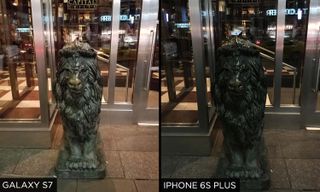
Take a look at our photo of the lion statues outside Capital Grille in New York City, which resulted in much brighter exposure and sharper details on the S7 compared to the iPhone 6s.

We saw similar results between the S7 Edge and iPhone 6s Plus, as a group of golden ornamental skulls at a New York bar looked brighter and more accurate in color on the Galaxy.
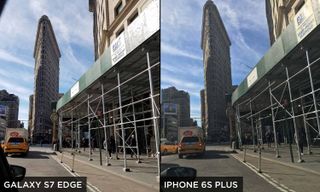
MORE: Which Phone Offers the Best Camera?
Inside, with low to medium light, we saw more-realistic colors from the iPhone 6s Plus. And photos taken in bright light and outdoors were comparable between the Apple and Samsung phones.

Last but not least, the 5-MP selfie-camera shots taken on the S7, S7 Edge, iPhone 6s and 6s Plus all look fairly sharp. But I give an edge to the Samsung because it has a wider-angle lens that lets in more of the background and potentially more of your peeps.
Winner: Galaxy S7 and S7 Edge. Samsung's camera is faster and is superior in low light.
Display
Both the S7 and S7 Edge sport Super AMOLED displays, which tend to offer richer (though oversaturated) colors, while the iPhone 6s and 6s Plus feature LCDs that put the focus on more-realistic hues.

The Galaxy S7 has a 5.1-inch screen, compared to the 4.7-inch display on the iPhone 6s. The S7 outpaces the iPhone in terms of resolution, at 2650 x 1440 pixels, versus just 1334 x 750 on the iPhone 6s. The S7 Edge also has a resolution advantage, at 2650 x 1440 versus 1920 x 1080 for the iPhone 6s Plus.
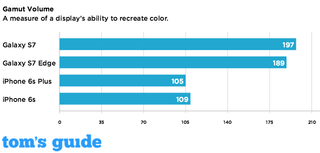
As expected, the S7 and S7 Edge screens display a wider range of colors, producing 196.6 and 189.2 percent of the sRGB spectrum, compared to 108.6 and 105.1 percent for the iPhone 6s and 6s Plus. On the other hand, the iPhones offer more-realistic colors, as their Delta-E error ratings (zero is best) were both under 0.5, compared to 3.5 for the Galaxy phones.
The brightness scores of the screens on the iPhone s6 and 6s Plus are in the same ballpark as the Galaxy S7 and S7 Edge showings, as all four handsets hit between 487 and 510 nits.
MORE: Galaxy S7 and S7 Edge: What's the Best Carrier?
When I watched the Batman V Superman trailer, Ben Affleck's skin looked warmer and Wonder Woman's shield popped more on the S7 Edge's screen compared to on the iPhone 6s Plus. I could also make out more rubble surrounding Affleck's Bruce Wayne character, thanks to the slightly better contrast on the Samsung.
Winner: Galaxy S7 and S7 Edge. Those who prefer more true-to-life colors will like the iPhones, but the Galaxy devices win because of their higher resolution.
Special Features
The Galaxy S7 Edge's most notable special feature is its Edge display, which lets you access app shortcuts or your favorite people, and perform various tasks with a tap, such as taking a selfie or messaging a specific person.

There's also a wider news ticker than on previous Galaxy Edge devices.
In addition to water resistance, both Samsung phones offer an always-on display, which allows you to look at the time, calendar and notifications without unlocking the devices. What's not so special about the software experience is the amount of carrier bloatware that's included, something you don't have to deal with on iPhones.
If you want to experience virtual reality, the Galaxy S7 works with the Gear VR, delivering immersive games and 360-degree videos right to your peepers.
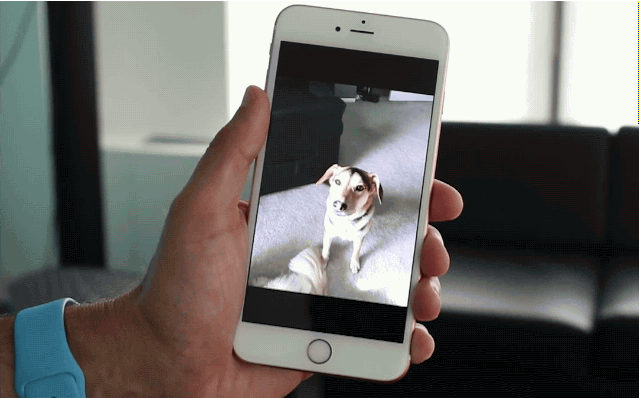
The iPhone 6s and 6s Plus have two strong special features of their own: Live Photos and 3D Touch. With Live Photos, the latest iPhones bring your pictures to life by recording a second of video and audio before and after the still shot. Facebook and Tumblr support Live Photos, as does Google Photos for backing up these files.

The 3D Touch feature has several uses, but the most straightforward one is the ability to press harder on a home screen icon to reveal various shortcuts, such as composing a new post on Instagram. There are also a number of games that support 3D Touch, adding a level of depth to game play; in Warhammer 30,000 Freeblade, for example, you press harder to activate secondary weapons.
Winner: iPhone 6s and 6s Plus. As much as we like the S7's ability to shrug off water and VR, Live Photos and 3D Touch both have more everyday appeal than do Samsung's special features.
Performance
The Galaxy S7 and S7 Edge and the iPhone 6s and 6s Plus are among the most powerful phones you can buy. The new Galaxy phones have Qualcomm's Snapdragon 820 CPU and 4GB of RAM, while the iPhones feature Apple's A9 chip and 2GB of RAM.
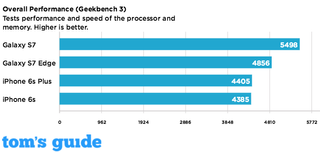
The S7 beat the latest iPhone on a couple of synthetic benchmarks. On Geekbench 3, which measures overall performance, the S7 and S7 Edge notched 5,448 and 5,330 on the multicore portion of the test, versus 4,385 for the iPhone 6s and 6s Plus.
On 3DMark Ice Storm Unlimited, which measures graphics performance, the Galaxy S7 Edge scored 27,851, edging out the iPhone 6s Plus, which registered 27,295. The S7 scored an even higher 28,883, compared to 26,070 for the iPhone 6s.

To test everyday performance, we opened the same apps on the S7 Edge and iPhone 6s Plus and timed how long the apps took to fully load. Marvel's Contest of Champions took 7.6 seconds to load on the Galaxy, compared to just 4.16 seconds on the iPhone. The iPhone was also faster to load the Clash Royale game, taking 6.45 seconds versus 8.68 seconds on the S7 Edge.
Although the S7 Edge focuses faster, its camera loaded just slightly behind the iPhone 6s Plus, taking about 1.2 seconds compared to 1 second for Apple's device. Lastly, the iPhone was slightly faster when exiting most apps to the home screen.
Winner: Draw. While the Galaxy S7 beats the iPhone 6s on synthetic tests, the iPhone offers a snappier real-world performance.
Battery Life
Samsung has added beefier batteries to its new phones: The Galaxy S7 has a 3,000-mAh battery, while the S7 Edge runs on a 3,600-mAh battery.

The result is a sizeable endurance gap between the new Galaxy phones and the Apple devices. The Galaxy S7 lasted 8 hours and 43 minutes on the Tom's Guide Battery Test, which involves continuous Web surfing over LTE at 150 nits of screen brightness. The iPhone 6s finished about 2 hours behind, at 6:46.
We saw a similar difference between the S7 Edge and the iPhone 6s Plus on the same test. The Galaxy lasted for a strong 10:09, compared to 8:16 for the bigger iPhone.
Winner: Galaxy S7 and S7 Edge. The new Samsungs both last longer than their iPhone foes.

The Galaxy S7 and S7 Edge win this contest with a score of 5 to 2. They offer sexier designs than the iPhone 6s and 6s Plus and are water-resistant, and they boast cameras that focus faster and perform generally better in low-light situations. While some people will prefer the more-realistic colors on the iPhone displays, the S7 and S7 Edge screens are sharper and offer more-saturated hues. Most importantly, the new Samsungs last significantly longer on a charge.
The iPhone 6s and 6s Plus are easier to use and lack carrier bloatware, and they are more innovative, with features like 3D Touch and Live Photos. And while the S7 and S7 Edge offer better benchmark scores, the iPhones feel faster in everyday use. Overall, though, Samsung wins this face-off.
| More Tom's Guide Smartphone Features |
| Galaxy S7 vs LG G5: Which Android Flagship Reigns Supreme? |
| Best Cheap Smartphones |
| Best and Worst Cell Phone Carriers |
Sign up to get the BEST of Tom’s Guide direct to your inbox.
Upgrade your life with a daily dose of the biggest tech news, lifestyle hacks and our curated analysis. Be the first to know about cutting-edge gadgets and the hottest deals.
Mark Spoonauer is the global editor in chief of Tom's Guide and has covered technology for over 20 years. In addition to overseeing the direction of Tom's Guide, Mark specializes in covering all things mobile, having reviewed dozens of smartphones and other gadgets. He has spoken at key industry events and appears regularly on TV to discuss the latest trends, including Cheddar, Fox Business and other outlets. Mark was previously editor in chief of Laptop Mag, and his work has appeared in Wired, Popular Science and Inc. Follow him on Twitter at @mspoonauer.

